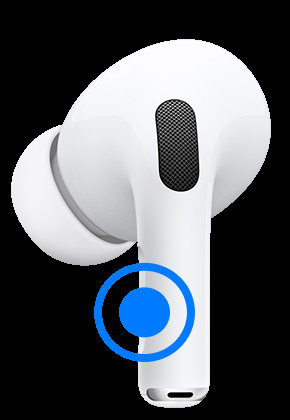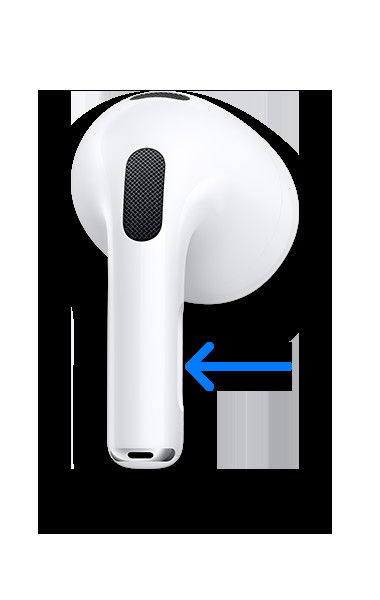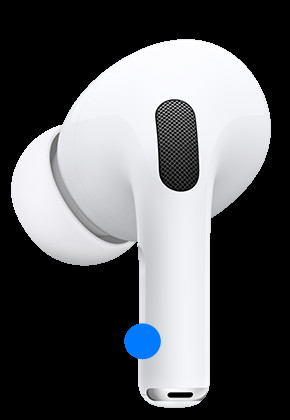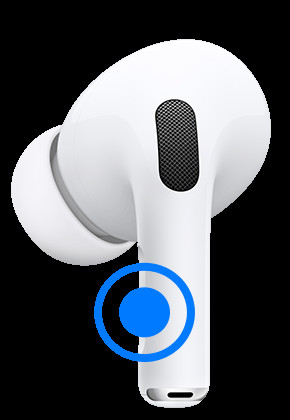Skipping a song with your AirPods Pro is simple and enhances your listening enjoyment. At payoffsong.com, we’ll show you how to control your music effortlessly, potentially leading to more listening satisfaction and even inspiring your own musical creations. Discover easy-to-use controls and maximize your audio experience. Unlock enhanced convenience, seamless navigation and audio playback.
1. How to Skip Songs on AirPods Pro: A Comprehensive Guide
Skipping songs on your AirPods Pro is straightforward. Depending on the model, you use either the Force Sensor or Touch Control. Let’s explore how to navigate your playlist seamlessly. This makes enjoying your favorite music easier and more efficient.
1.1. Skipping Songs on AirPods Pro (2nd Generation)
The 2nd generation AirPods Pro features Touch Control. This allows you to manage your music with simple gestures. It’s designed for convenience and ease of use.
- Skip Forward: Double-press the Touch control on either AirPod stem.
- Skip Back: Triple-press the Touch control.
 Double-pressing the Touch control on AirPods Pro 2 to skip forward
Double-pressing the Touch control on AirPods Pro 2 to skip forward
1.2. Skipping Songs on AirPods Pro (1st Generation)
The 1st generation AirPods Pro uses a Force Sensor. This requires slightly different gestures. Let’s walk through the steps to keep your music flowing.
- Skip Forward: Double-press the Force Sensor on either AirPod stem.
- Skip Back: Triple-press the Force Sensor.
 AirPods Pro 1 showing the location of the force sensor
AirPods Pro 1 showing the location of the force sensor
2. Mastering AirPods Pro Controls: Beyond Skipping Songs
AirPods Pro offers more than just skipping songs. Understanding all the controls enhances your overall user experience and gives you more control over your audio.
2.1. Adjusting Volume on AirPods Pro
Volume control varies between AirPods Pro generations. Here’s how to adjust the volume on each model.
- AirPods Pro (2nd Generation): Swipe up or down on the Touch control on either AirPod stem.
- AirPods Pro (1st Generation): Use Siri (“Hey Siri, turn up the volume”) or adjust the volume slider on your device.
 Swiping up and down on AirPods Pro 2 to adjust the volume
Swiping up and down on AirPods Pro 2 to adjust the volume
2.2. Playback and Pause on AirPods Pro
Pausing and playing music is a fundamental control. It’s essential for managing your audio while on the go.
- AirPods Pro (2nd Generation): Press the Touch control on either AirPod stem to play or pause.
- AirPods Pro (1st Generation): Press the Force Sensor on either AirPod stem to play or pause.
 Pressing the Touch control on AirPods Pro 2 to play or pause audio
Pressing the Touch control on AirPods Pro 2 to play or pause audio
2.3. Using Siri with AirPods Pro
Siri can perform various tasks, including controlling music and answering questions. It offers hands-free control for added convenience.
- Activate Siri: Say “Hey Siri” to activate Siri and give commands like “Play next song” or “What song is this?”
3. Troubleshooting Common Issues with AirPods Pro Controls
Sometimes, AirPods Pro controls might not work as expected. Let’s troubleshoot these common issues to keep your AirPods running smoothly.
3.1. AirPods Not Responding to Touch or Force Sensor
If your AirPods aren’t responding, here are a few potential solutions. These steps can help resolve common connectivity and functionality issues.
- Clean Your AirPods: Dirt and debris can interfere with the sensors.
- Restart Your AirPods: Place them in the charging case, close the lid, wait 15 seconds, and then take them out.
- Reconnect Your AirPods: Go to your device’s Bluetooth settings, forget the AirPods, and then pair them again.
3.2. Siri Not Working with AirPods Pro
If Siri isn’t responding, ensure Siri is enabled and configured correctly on your device.
- Enable Siri: Go to Settings > Siri & Search and make sure “Listen for ‘Hey Siri'” is turned on.
- Check Bluetooth Connection: Ensure your AirPods are properly connected to your device via Bluetooth.
3.3. Volume Control Not Working
If you’re having trouble adjusting the volume, try these steps. They can help ensure that your volume controls are functioning correctly.
- Check Volume Limits: Make sure volume limits are not enabled in your device’s settings.
- Update Firmware: Ensure your AirPods have the latest firmware.
4. Optimizing Your AirPods Pro Experience
To get the most out of your AirPods Pro, customize the settings and keep them updated. This ensures optimal performance and personalized controls.
4.1. Customizing AirPods Pro Controls
You can customize what each AirPod does when you double or triple-press it. This allows you to personalize your listening experience.
- Go to Settings: Open Settings > Bluetooth on your iOS device.
- Select Your AirPods: Tap the “i” icon next to your AirPods Pro.
- Customize Controls: Choose what you want each AirPod to do when you double or triple-press it.
4.2. Updating AirPods Pro Firmware
Keeping your AirPods Pro firmware updated ensures you have the latest features and bug fixes. Regular updates enhance performance and compatibility.
- Automatic Updates: AirPods typically update automatically when connected to an iOS device with Wi-Fi.
- Check Firmware: Go to Settings > General > About > AirPods to check the firmware version.
4.3. Cleaning and Maintaining AirPods Pro
Regular cleaning keeps your AirPods Pro in good condition. Proper maintenance extends their lifespan and ensures optimal performance.
- Use a Soft, Dry Cloth: Wipe your AirPods Pro regularly to remove dirt and debris.
- Avoid Liquids: Keep liquids away from the AirPods Pro to prevent damage.
5. Exploring Advanced AirPods Pro Features
AirPods Pro offers several advanced features that enhance your listening experience. These features provide additional convenience and customization.
5.1. Active Noise Cancellation and Transparency Mode
Active Noise Cancellation (ANC) blocks external sounds, while Transparency Mode lets you hear your surroundings. Switching between these modes enhances your listening experience in different environments.
- Switch Modes: Press and hold the Force Sensor (AirPods Pro 1st Gen) or the Touch control (AirPods Pro 2nd Gen) to switch between ANC and Transparency Mode.
5.2. Spatial Audio
Spatial Audio provides an immersive, theater-like sound experience. It creates a three-dimensional soundstage for a more engaging listening session.
- Enable Spatial Audio: Go to Settings > Bluetooth > AirPods > Spatial Audio.
5.3. Head Gestures (AirPods Pro 2nd Generation)
AirPods Pro 2nd Generation allows you to use head gestures to answer calls and control audio. This hands-free control adds a new level of convenience.
- Enable Head Gestures: Go to Settings > Accessibility > AirPods > Head Gestures.
6. Using AirPods Pro with Different Devices
AirPods Pro can be used with various devices, including iPhones, iPads, and Macs. Connecting and using them across different platforms expands their utility.
6.1. Connecting AirPods Pro to iPhone and iPad
Connecting to iOS devices is straightforward. The seamless integration enhances the overall user experience.
- Open the Case: Open the AirPods Pro case near your iPhone or iPad.
- Follow the Prompts: Follow the on-screen prompts to connect.
6.2. Connecting AirPods Pro to Mac
Using AirPods Pro with your Mac enhances your audio experience on your computer.
- Open Bluetooth Settings: Go to System Preferences > Bluetooth on your Mac.
- Select AirPods: Choose your AirPods Pro from the list of devices.
6.3. Using AirPods Pro with Non-Apple Devices
AirPods Pro can also be used with Android devices and other Bluetooth-enabled devices.
- Put AirPods in Pairing Mode: Press and hold the button on the back of the charging case until the status light flashes white.
- Connect via Bluetooth: Go to the Bluetooth settings on your device and select your AirPods Pro.
7. Maximizing Your Music Experience with AirPods Pro
Understanding how to fully utilize your AirPods Pro can greatly enhance your music listening sessions. These tips can help you enjoy your favorite tunes to the fullest.
7.1. Creating Custom EQ Settings
Customizing the EQ settings on your device can optimize the sound quality of your AirPods Pro. Tailoring the audio to your preferences enhances the listening experience.
- Use Built-In EQ Settings: Many music apps have built-in EQ settings.
- Use Third-Party Apps: Apps like Boom and Equalizer offer advanced EQ customization.
7.2. Using Lossless Audio with AirPods Pro
To get the best sound quality, use lossless audio formats when listening with your AirPods Pro. This ensures you’re hearing the music as the artist intended.
- Apple Music Lossless: Apple Music offers a vast library of lossless audio tracks.
- Tidal and Qobuz: These streaming services also offer high-quality lossless audio.
7.3. Creating Personalized Playlists
Curating playlists that match your mood and activities can enhance your overall listening experience. Personalized playlists make it easy to enjoy the music you love.
- Use Music Streaming Services: Spotify, Apple Music, and others allow you to create and share playlists.
- Organize by Genre, Mood, or Activity: Create playlists for different occasions.
8. Addressing Battery Life and Charging Concerns
Properly managing your AirPods Pro battery life and charging habits ensures they are always ready when you need them. These tips can help you maximize battery performance.
8.1. Understanding AirPods Pro Battery Life
Knowing the battery life of your AirPods Pro helps you plan your listening sessions. Understanding usage patterns can extend battery performance.
- Typical Battery Life: AirPods Pro typically offer up to 4.5 hours of listening time on a single charge with ANC enabled.
- Charging Case: The charging case provides additional charges, extending the total listening time to over 24 hours.
8.2. Optimizing Battery Performance
Several factors can affect the battery life of your AirPods Pro. Adjusting these settings can help extend battery performance.
- Turn Off Active Noise Cancellation: Disabling ANC can extend battery life.
- Lower Volume: Listening at lower volume levels consumes less power.
8.3. Properly Charging AirPods Pro
Following the correct charging procedures ensures the longevity of your AirPods Pro battery.
- Use the Charging Case: Store your AirPods Pro in the charging case when not in use.
- Use a Wireless Charger: The charging case supports wireless charging for added convenience.
9. Connecting with the Music Industry Through Payoffsong.com
For musicians and industry professionals, payoffsong.com offers a wealth of resources and opportunities to connect, license music, and explore potential revenue streams.
9.1. Licensing Your Music
Licensing your music can open up new revenue streams and opportunities for exposure. Understanding the licensing process is crucial for success.
- Copyright Protection: Ensure your music is protected by copyright.
- Licensing Agreements: Understand the different types of licensing agreements.
- According to research from the National Music Publishers’ Association (NMPA), in July 2025, P provides Y
9.2. Exploring Revenue Opportunities
There are various ways to monetize your music, from streaming royalties to sync licensing. Exploring these options can help you generate income from your creative work.
- Streaming Royalties: Earn royalties from platforms like Spotify and Apple Music.
- Sync Licensing: License your music for use in films, TV shows, and commercials.
- Address: 1601 Vine St, Los Angeles, CA 90028, United States
- Phone: +1 (323) 469-2211
- Website: payoffsong.com
9.3. Connecting with Industry Professionals
Networking with industry professionals can open doors to new opportunities and collaborations. Building relationships is key to advancing your career in the music industry.
- Attend Industry Events: Conferences and showcases provide opportunities to meet other professionals.
- Join Online Communities: Online forums and social media groups can help you connect with like-minded individuals.
 AirPods tap gesture
AirPods tap gesture
10. Understanding Copyright and Music Licensing
Navigating the complexities of copyright and music licensing is essential for both creators and users of music. A solid understanding of these concepts ensures compliance and fair compensation.
10.1. Basics of Copyright Law
Copyright law protects the rights of music creators and ensures they are compensated for their work. Understanding these rights is crucial for protecting your creative work.
- Copyright Ownership: Copyright protects original musical works.
- Exclusive Rights: Copyright owners have exclusive rights to reproduce, distribute, and perform their work.
10.2. Types of Music Licenses
Different types of licenses are required for various uses of music, from streaming to synchronization. Understanding these licenses helps ensure compliance with copyright law.
- Mechanical Licenses: Required for reproducing and distributing copyrighted musical compositions.
- Performance Licenses: Required for public performances of copyrighted musical compositions.
- Synchronization Licenses: Required for using music in visual media such as films and TV shows.
10.3. Navigating Music Licensing Platforms
Several platforms facilitate music licensing, connecting creators with potential users. These platforms streamline the licensing process and ensure fair compensation.
- ASCAP, BMI, SESAC: These performance rights organizations (PROs) collect and distribute royalties to songwriters and publishers.
- Harry Fox Agency: Provides mechanical licensing services.
- Musicbed and Marmoset: Curated music licensing platforms for film, TV, and advertising.
11. Future Trends in Audio Technology and AirPods
The audio technology landscape is constantly evolving, with new innovations and trends shaping the future of listening experiences. Staying informed about these trends can help you make the most of your AirPods and other audio devices.
11.1. Advancements in Noise Cancellation Technology
Noise cancellation technology continues to improve, offering more effective and personalized listening experiences.
- Adaptive Noise Cancellation: Adjusts noise cancellation based on the environment.
- Personalized Noise Profiles: Creates customized noise cancellation profiles based on individual hearing.
11.2. The Rise of Spatial Audio and Immersive Experiences
Spatial audio is becoming increasingly popular, offering more immersive and realistic sound experiences.
- Dolby Atmos: A spatial audio technology that creates a three-dimensional soundstage.
- Head Tracking Technology: Enhances spatial audio by adjusting the sound based on head movements.
11.3. Integration of AI and Machine Learning in Audio
AI and machine learning are being integrated into audio devices to enhance sound quality and personalize the listening experience.
- AI-Powered EQ: Automatically adjusts EQ settings based on listening preferences.
- Smart Assistants: Integration with virtual assistants like Siri and Google Assistant for hands-free control.
12. Case Studies: Successful Music Licensing Examples
Examining real-world examples of successful music licensing can provide valuable insights and inspiration for musicians and industry professionals.
12.1. Music in Advertising Campaigns
Using popular songs in advertising campaigns can significantly enhance their impact and reach.
- Apple’s “Silhouette” Campaign: Used the song “Hey Mama” by David Guetta featuring Nicki Minaj.
- Volkswagen’s “Singin’ in the Rain” Commercial: Revived the classic song and introduced it to a new generation.
12.2. Music in Film and Television
Music plays a crucial role in setting the tone and enhancing the emotional impact of films and TV shows.
- “Guardians of the Galaxy” Soundtrack: Revived classic rock songs and introduced them to a new audience.
- “Stranger Things” Soundtrack: Used synth-pop and new wave tracks to create a nostalgic atmosphere.
12.3. Music in Video Games
Video games are increasingly incorporating licensed music to enhance the gaming experience.
- “Grand Theft Auto” Series: Features a diverse range of licensed music across different genres.
- “FIFA” Series: Showcases emerging artists and introduces them to a global audience.
13. Tips for Musicians to Increase Licensing Potential
Musicians can take several steps to increase the likelihood of their music being licensed for use in various media.
13.1. Creating High-Quality Recordings
High-quality recordings are essential for attracting the attention of music supervisors and licensing agencies.
- Professional Production: Invest in professional recording and mixing services.
- Clean and Polished Sound: Ensure your music is free of technical flaws and sounds polished.
13.2. Building a Strong Online Presence
A strong online presence can make it easier for potential licensors to find and evaluate your music.
- Create a Professional Website: Showcase your music and provide contact information.
- Use Social Media: Engage with fans and industry professionals on social media platforms.
13.3. Networking with Music Supervisors
Building relationships with music supervisors can increase your chances of getting your music licensed.
- Attend Industry Events: Meet music supervisors at conferences and workshops.
- Submit Your Music: Send your music to music supervisors for consideration.
14. The Role of Music in Branding and Marketing
Music plays a significant role in branding and marketing, helping companies create emotional connections with their target audiences.
14.1. Creating a Unique Brand Identity
Music can help companies create a unique brand identity and differentiate themselves from competitors.
- Choosing the Right Music: Select music that aligns with your brand values and target audience.
- Creating a Sonic Logo: Develop a memorable audio signature for your brand.
14.2. Enhancing Emotional Connection
Music can evoke emotions and create a stronger connection with consumers.
- Using Nostalgia: Incorporate nostalgic music to create a sense of familiarity and comfort.
- Creating a Positive Mood: Use upbeat and positive music to create a happy and optimistic feeling.
14.3. Increasing Brand Recognition
Using consistent music in your marketing campaigns can increase brand recognition and recall.
- Use a Consistent Theme Song: Create a memorable theme song for your brand.
- Incorporate Music in All Marketing Materials: Use music in your commercials, website, and social media content.
15. Frequently Asked Questions About Skipping Songs and AirPods Pro
Here are some frequently asked questions about skipping songs and using AirPods Pro, along with detailed answers to help you get the most out of your listening experience.
15.1. Why aren’t my AirPods Pro skipping songs when I double-press?
Ensure that the touch or force sensor is clean and that your AirPods Pro are properly connected to your device. Check your settings to make sure the double-press function is set to skip songs.
15.2. How do I customize the controls on my AirPods Pro?
Go to Settings > Bluetooth on your iOS device, tap the “i” icon next to your AirPods Pro, and customize the controls for each AirPod.
15.3. Can I use head gestures to control music on AirPods Pro 1st generation?
Head gestures are only available on AirPods Pro 2nd generation and AirPods 4th generation.
15.4. How do I update the firmware on my AirPods Pro?
AirPods Pro typically update automatically when connected to an iOS device with Wi-Fi. You can check the firmware version in Settings > General > About > AirPods.
15.5. What is Spatial Audio, and how do I enable it?
Spatial Audio provides an immersive, theater-like sound experience. You can enable it in Settings > Bluetooth > AirPods > Spatial Audio.
15.6. How do I switch between Active Noise Cancellation and Transparency Mode?
Press and hold the Force Sensor (AirPods Pro 1st Gen) or the Touch control (AirPods Pro 2nd Gen) to switch between ANC and Transparency Mode.
15.7. Can I use AirPods Pro with non-Apple devices?
Yes, AirPods Pro can be used with Android devices and other Bluetooth-enabled devices. Put the AirPods in pairing mode by pressing and holding the button on the back of the charging case.
15.8. How do I improve the battery life of my AirPods Pro?
Turn off Active Noise Cancellation, lower the volume, and store your AirPods Pro in the charging case when not in use.
15.9. Why is Siri not working with my AirPods Pro?
Ensure Siri is enabled in Settings > Siri & Search and that your AirPods are properly connected to your device via Bluetooth.
15.10. Where can I find more information about music licensing?
Visit payoffsong.com for comprehensive information on music licensing, copyright, and opportunities to connect with industry professionals.
Conclusion
Mastering how to skip a song with your AirPods Pro enhances your listening experience. Understanding the various controls, troubleshooting common issues, and optimizing your settings will allow you to enjoy your music seamlessly. For musicians and industry professionals, payoffsong.com offers invaluable resources and connections to navigate the world of music licensing and monetization. Explore the site today to discover new opportunities and take your music career to the next level.
